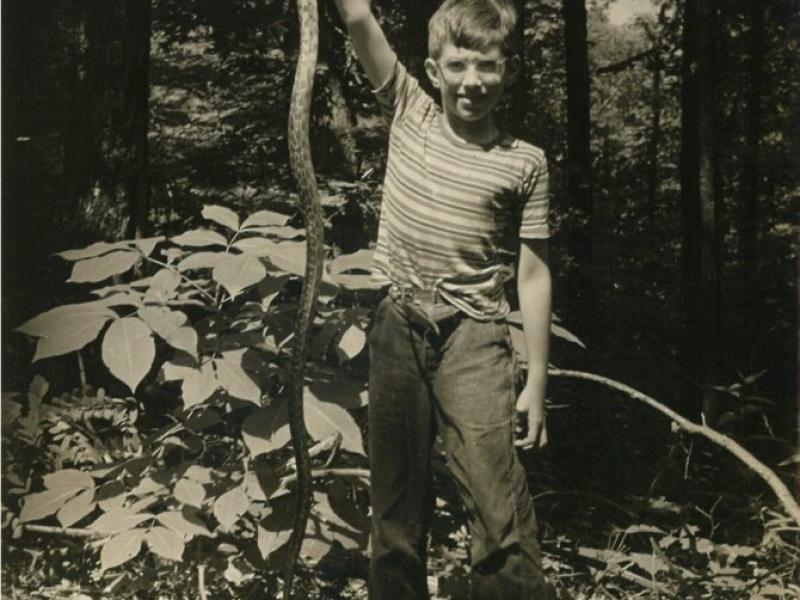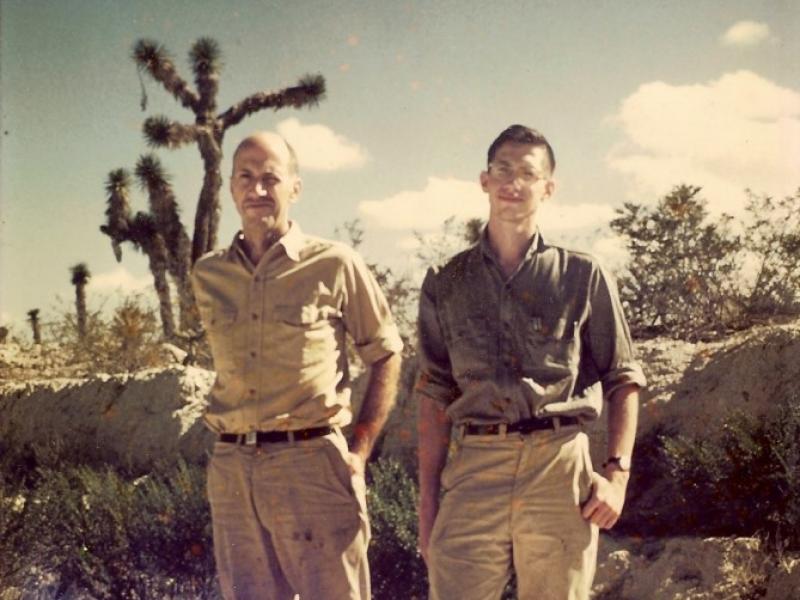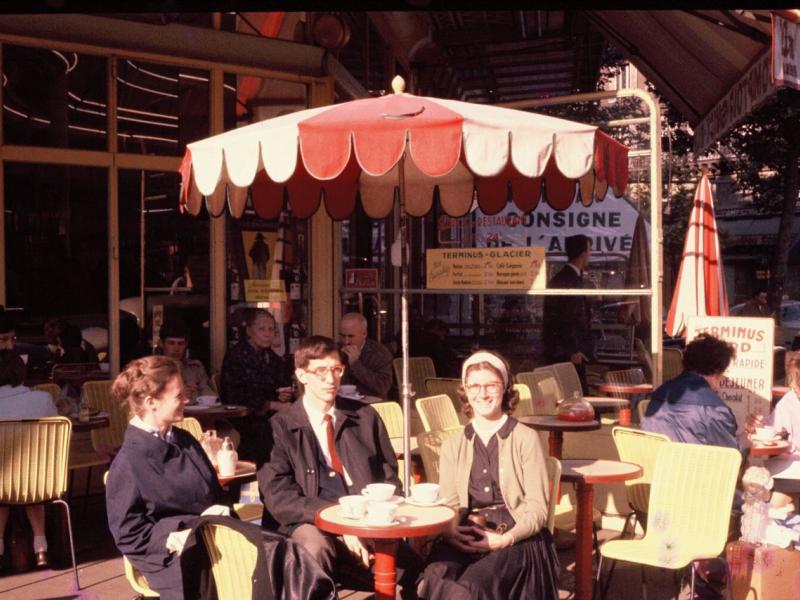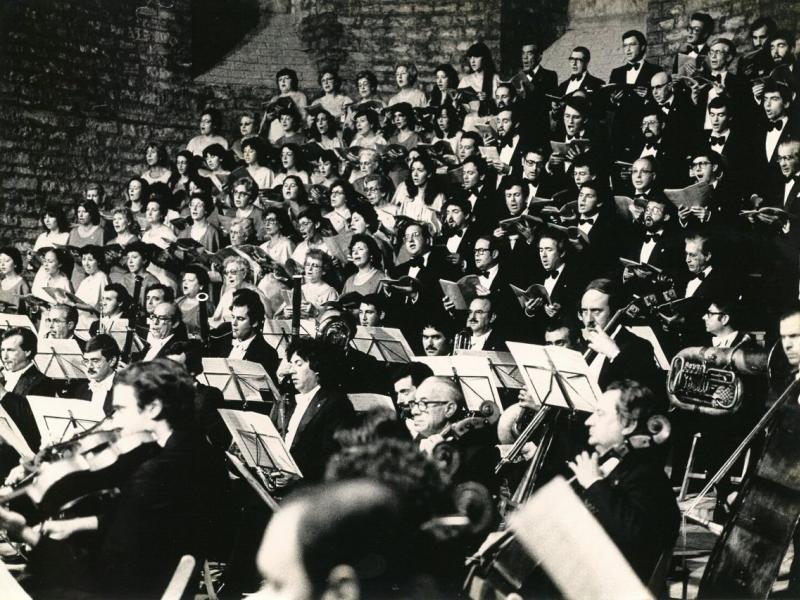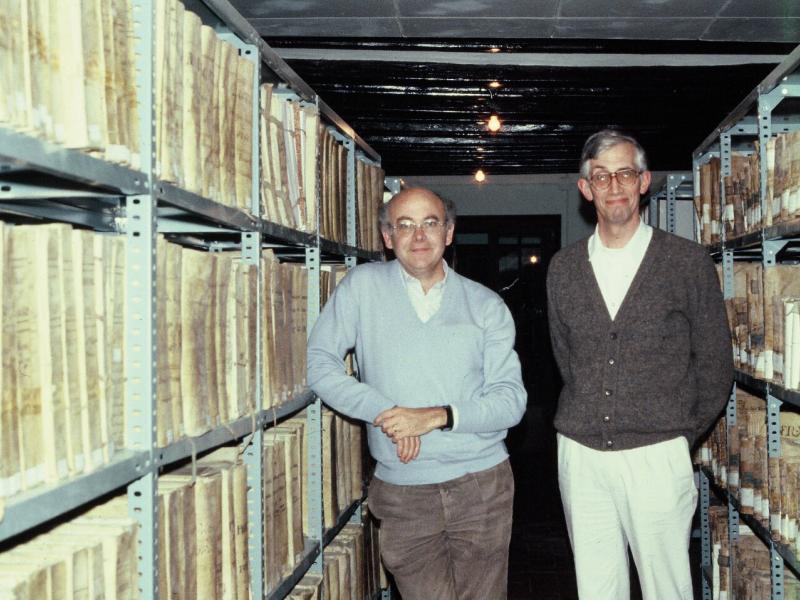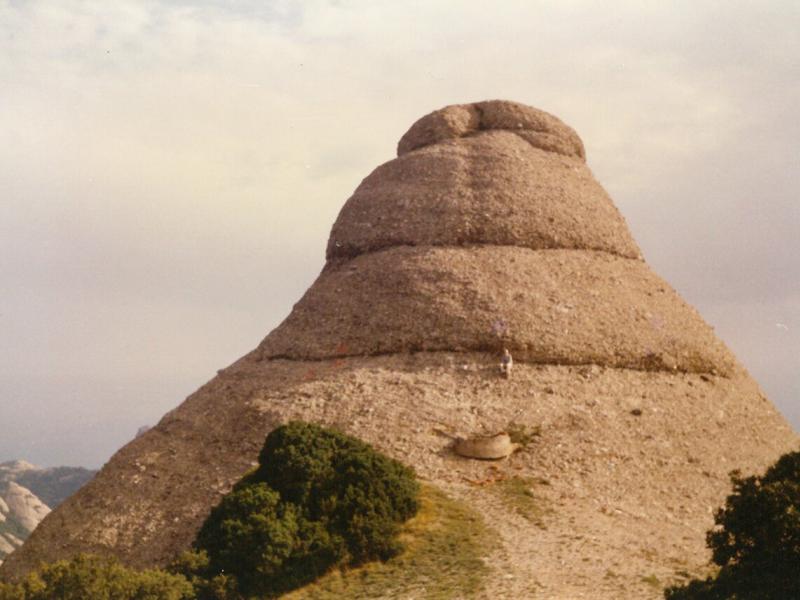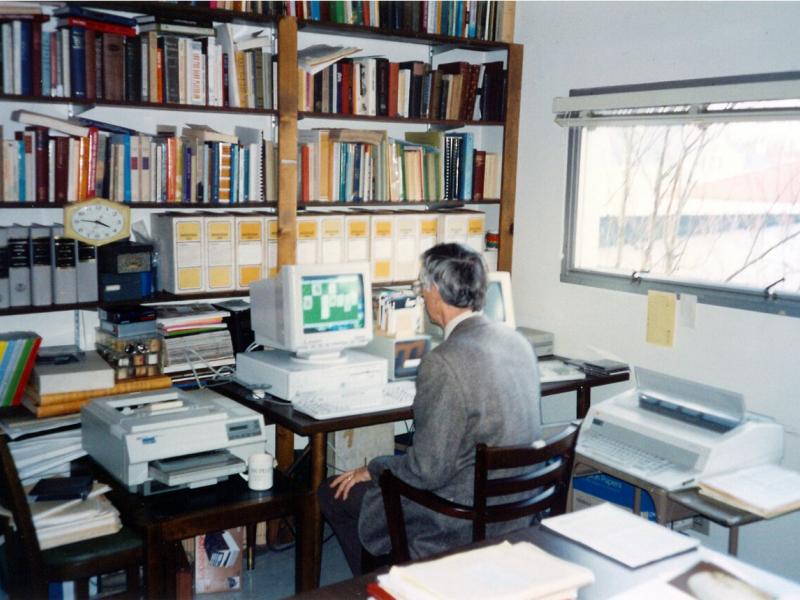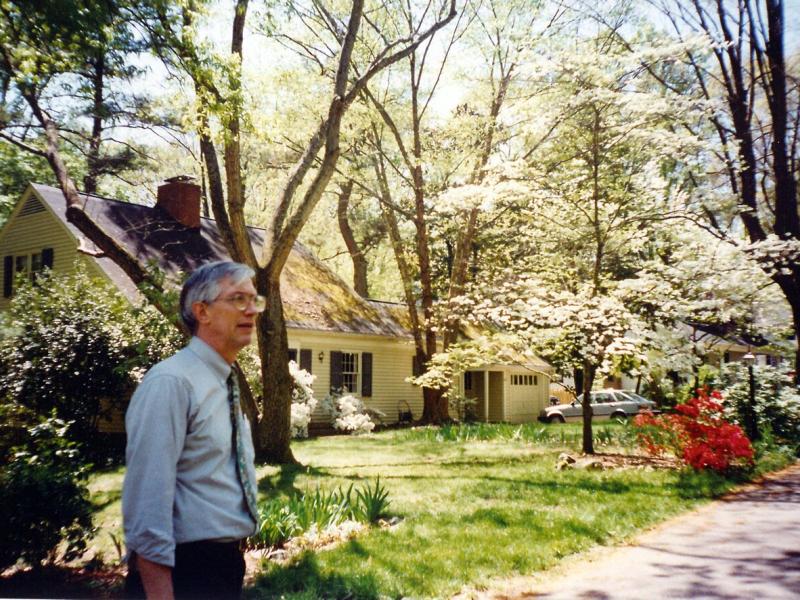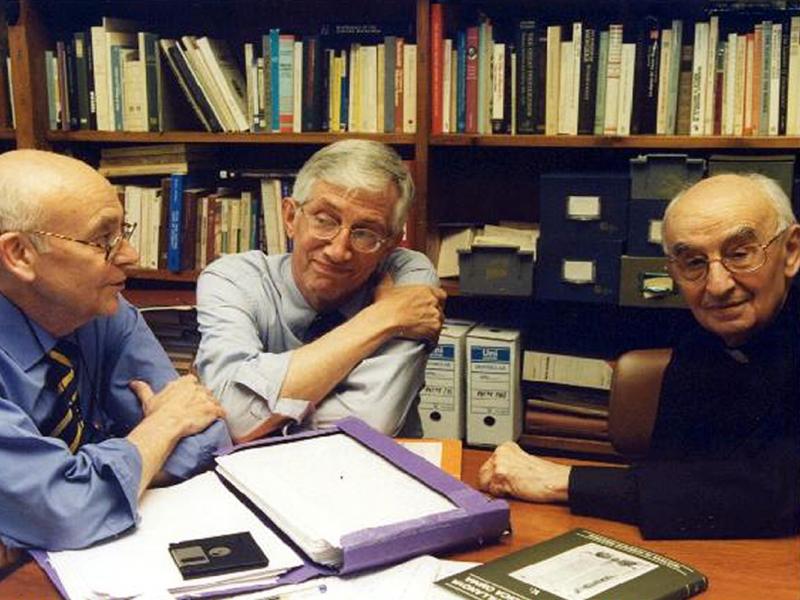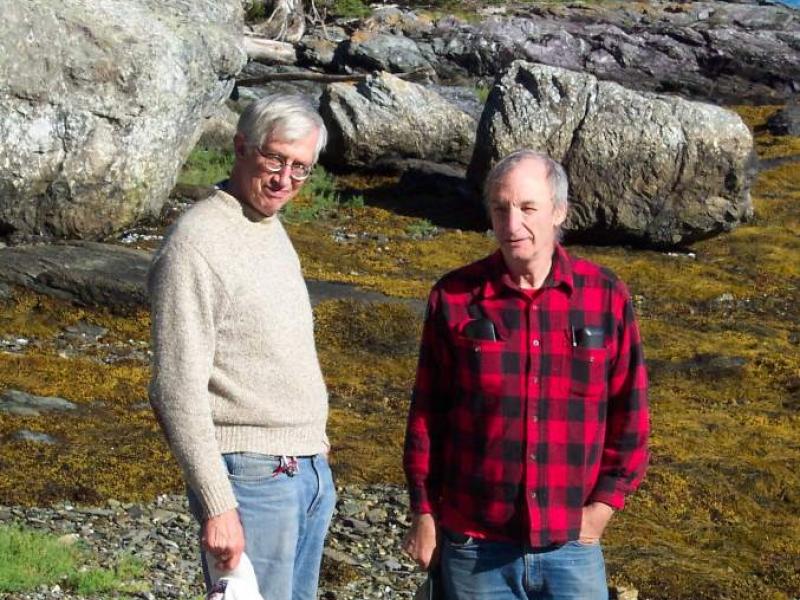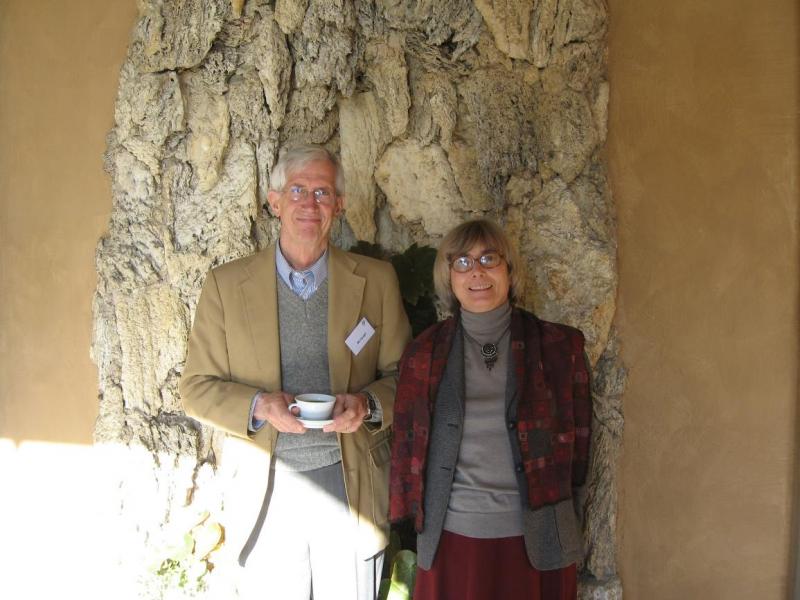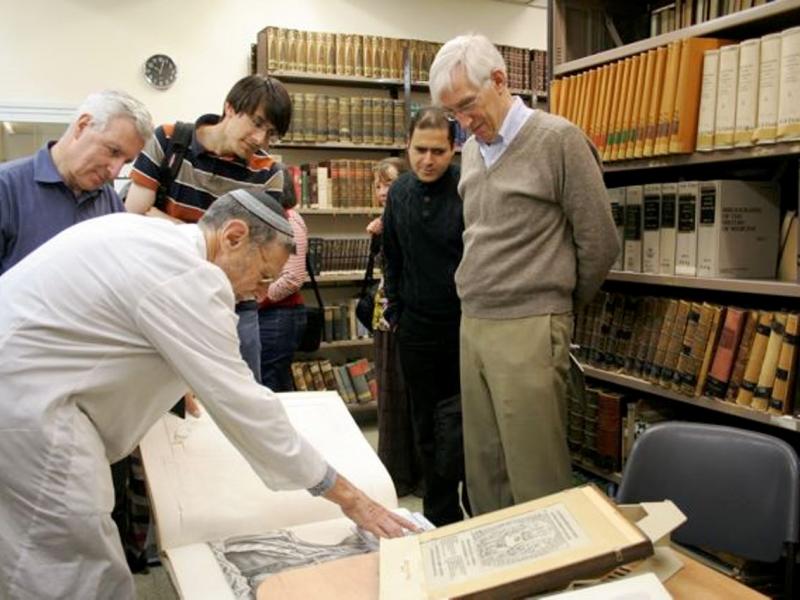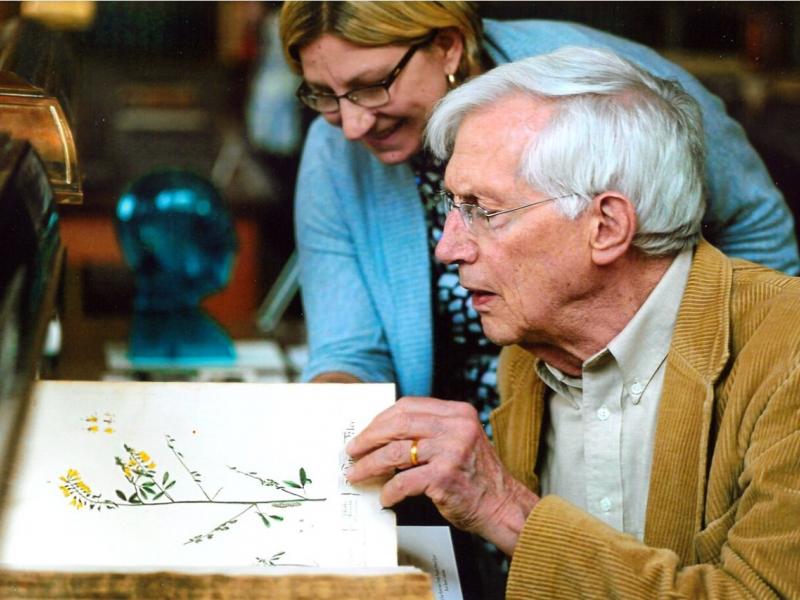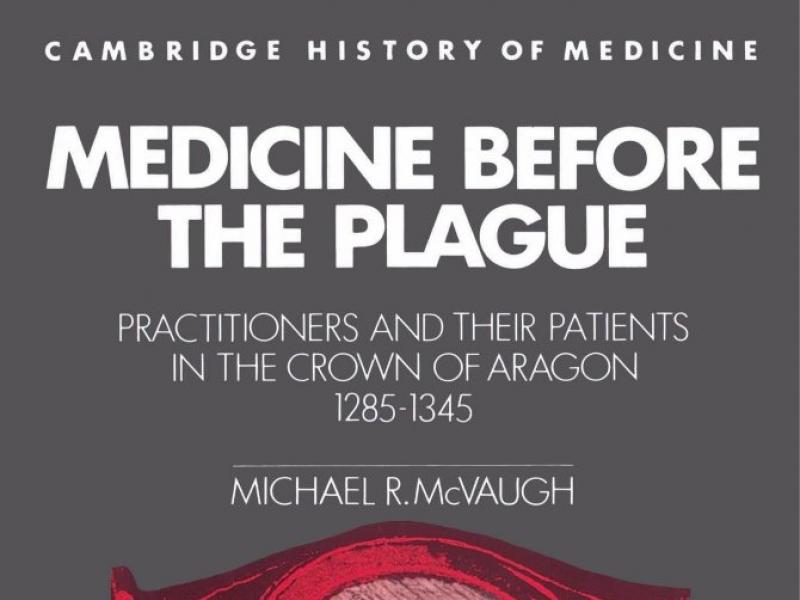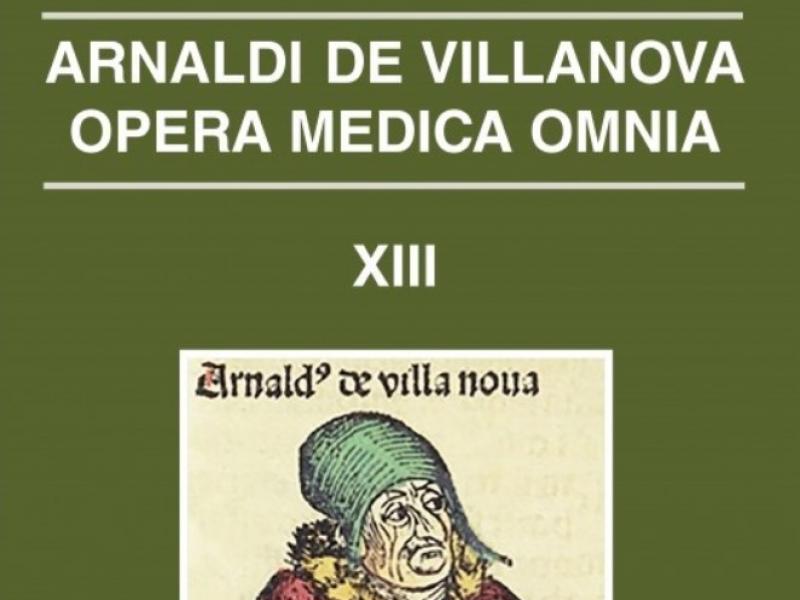Michael R. McVaugh (1938)
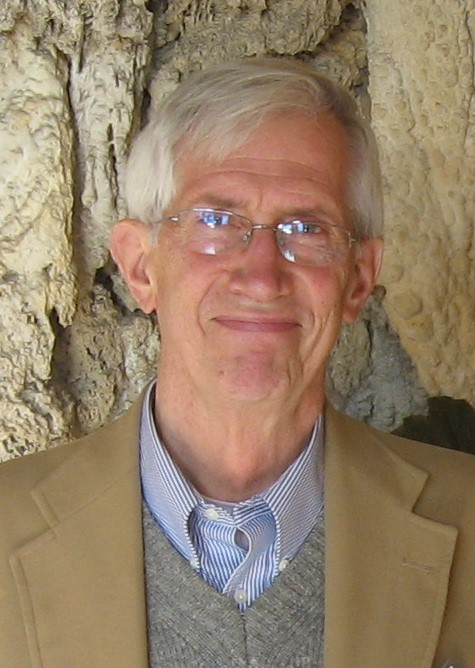
Michael Mcvaugh is one of the most notable and influential historians of medieval medicine in the recent development of that field. His scholarly corpus is considerable, bringing together two kinds of work.
One is a collection of critical editions of medical and surgical writing that are essential for an understanding of medieval medical thought. Here should be emphasized his commitment to the medical writings of Arnau de Vilanova (c. 1240–1311): McVaugh is one of the founders of the series that provides a critical edition of all the medical writings of this Valencian physician, a series still in course of publication (Arnaldi de Villanova Opera Medica Omnia, AVOMO). At the same time, he has published a series of critical editions of other texts, with particular interest in Arabic and Hebrew writings and their translation by Latin scholars.
On the other hand, he is the author of a number of studies, articles and monographs, concerning the social history of medicine in the thirteenth and fourteenth centuries, building on the enormous documentary corpus accessible in the many archives of the old Crown of Aragon. This territorial complex has been McVaugh's principal focus of investigation, providing a paradigmatic example for the study of the construction of a new medical system coming into existence in western Europe from the thirteenth century on.
Within this research framework, McVaugh has been able to demonstrate a continuing interaction between the medical theory and the medical practice of the later centuries of the Middle Ages, all based upon a rigorous, meticulous analysis of the sources.
The irresistible attraction of Arnau de Vilanova
Michael McVaugh was born 9 December 1938 in Washington, D.C. (USA). Both his parents had earned a Ph.D. degree in botany, and his father Rogers McVaugh worked for the Department of Agriculture during World War II. At the end of the war his father accepted a curatorship in botany at the University of Michigan, and the family moved from Washington to Ann Arbor (MI) in 1946. His father specialized in the taxonomy of the plants of Western Mexico (Jalisco, Colima, Nayarit, Guanajuato, etc.) and made regular research trips to the region for the next thirty years, and Spanish newspapers (El Sol de Guadalajara) and books began to lie around the house. This awakened Michael’s interest in foreign languages; he began his acquaintance with Spanish now, and at the University’s high school he acquired some preliminary skills in French and Latin as well, though he thought he might seek a career in chemistry.
Between 1956 and 1960 he attended Harvard College, which allowed him to fuse his interest in science with a new interest in medieval history. While still in high school, he had read a historical novel about Arnau of Vilanova that fascinated him; a senior scholar at Michigan had told him that Arnau was an important figure, so that when he went to Harvard he took courses in medieval history, majored in the history of science, and wrote an honors thesis examining Arnau’s De simplicibus; he ordered microfilm of a manuscript of the work from the Bibliothèque nationale de France, in Paris, and developed his knowledge of Latin to the point that he could (amateurishly, of course) edit a portion of the text. His work was awarded a degree magna cum laude.
At Harvard he took courses with two young professors of medieval science, John Murdoch and Edward Grant, who had been trained at the University of Wisconsin by Marshall Clagett, who might be thought of as the founder of the history of medieval science in the United States: Clagett had been inspired by Anneliese Maier’s example to believe that the close study of medieval scientific texts, and their edition from manuscript sources, was the necessary foundation for the study of medieval science. Murdoch and Grant communicated this vision to McVaugh, but his interest in Arnau of Vilanova meant that he extended this idea from medieval science to medieval medicine. In 1960, as McVaugh graduated, Murdoch took a position at Princeton University, and he decided to pursue graduate study with Murdoch at Princeton in the history of science. He was already thinking that Arnau’s Aphorismi de gradibus, which combined medical thinking with the mathematics of science, might be a fruitful subject to pursue for a PhD.
From medieval medical manuscripts to the AVOMO
He followed this plan while a student at Princeton, 1960-64. His graduate studies prepared him for a position in the general history of science, ready to teach the subject from Plato to NATO, but he looked forward to the time when he could pursue his own special interests, which now began to include the subject of medieval medical translations; with them in mind, he began the study of Arabic. In 1962 he was awarded a graduate fellowship by the National Science Foundation that allowed him (and his new wife Julia) to spend the next year in study in Paris, resident in the Cité Universitaire. Through the kindness of Mlle. Marie-Thérèse d’Alverny at Paris, a good friend of John Murdoch, he was given the task of making an index of the medical texts in the Bibliothèque nationale, which paid him enough for occasional meals but much more importantly began to make him acquainted with the broad span of medieval medical literature, published and unpublished.
He returned to Princeton in 1963 to work on a study of Arnau’s Aphorismi for a dissertation, but he had not completed it when he was offered a position as assistant professor of history at the University of North Carolina, to teach not medieval history but the general history of science. He moved there in September 1964. On his arrival, he soon realized that his teaching would need to involve more than narrow medieval issues to earn his department’s endorsement, and over the next ten years or so he and a colleague at nearby Duke University were at work on a history of the attempts to create an academic science of parapsychology, or “extra-sensory perception,” as its champion at Duke, Professor J. B. Rhine, had named it. Their history, which neither accepted or denied the reality of “ESP,” was published in 1980.
He had not given up his dream of preparing an edition and study of Arnau of Vilanova’s Aphorismi de gradibus, however, and he continued work on this while writing about parapsychology. In the early 1970s he showed a draft of his work on the Aphorismi to Marshall Clagett, who thought well enough of it to show it to Guy Beaujouan at the École Pratique des Hautes Études in Paris; Beaujouan showed it to Juan Antonio Paniagua, the leading Arnaldian scholar of the day, who was interested enough to show it to Luis García Ballester, then at Granada. Luis was enthusiastic, and proposed publishing it as the first in a possible series of editions of Arnau’s Opera Medica, and Paniagua supported the idea, though he admitted that he had little confidence that the series would be successful. The volume appeared in 1975 as “vol. II,” published by Granada and Barcelona together; McVaugh and García Ballester, with Don Juan Antonio, formed an Editorial Committee for the new series, and began to imagine the contents of other volumes and scholars who might undertake those texts. His interest in Arabic led him to undertake an edition of Arnau’s translation from that language of Galen’s De rigore; he was disappointed to find that no Arabic manuscripts of the work seemed to be known, but he worked with a young colleague in classics and edited the Latin version in close comparison with the Greek, which appeared in 1983 as “vol. XVI” of AVOMO, the Arnaldi de Villanova Opera Medica Omnia.
The social context of Galenism and the Crown of Aragon as a case study
In the meantime the field of general history of science was undergoing a change of orientation. Until the mid-1960s it had focused on the development of scientific ideas, in something of a social vacuum, but from that point it paid increasing attention to the social framework of science, and this led McVaugh to wonder if it might be possible to understand the institutional dynamics at Arnau’s university of Montpellier that had shaped his medical thought, or to study the social world in which that thought was applied. But where was the raw data to be found? A chance conversation with Robert I. Burns, the historian of medieval Valencia, led him to Jesús Ernest Martinez Ferrando’s Jaime II de Aragón: su vida familiar (1948), which hinted at the wealth of records that might be found in the Arxiu de la Corona d’Aragó (ACA). Brief exploratory visits to Barcelona in the summers of 1977 and 1979 revealed how much material relevant to medical history was buried in the registers of the ACA. He applied for grants that would allow him a longer stay, and was awarded a Guggenheim fellowship that made it possible for him to live in Barcelona for a year. During 1981–1982 he and his wife lived in an apartment in the Santa Anna Street, in the house where Josep Maria Folch i Torres had been born, and he spent as much time as he could in the Arxiu, just a ten-minute walk away, reading through the Cancelleria’s registers one after another, full a full, and then those in the Cathedral archives. Their home was only ten minutes’ walk from the Palau de la Música, too, where they were admitted to sing with the Orfeó Català, and they also learned Catalan.
The excitement of that year convinced him that it might be profitable to search the documentation in other archives of the old Crown of Aragon, and for the next ten years he spent part of almost every year in more and more archives besides those of Barcelona. In the summer of 1983 it was Valencia, where García Ballester arranged for him to live in his old Col·legi Lluís Vives; in 1986, Zaragoza, Huesca, Daroca in Aragon; then Luis and he made a joint investigation in Lleida and Tarragona, for by now they were united in planning a social history of Catalan medicine that would compare that world before and after the plague of 1348: Luis searched the registers after 1348, McVaugh searched the ones before that date, and they shared their discoveries. In the summer of 1987 one of Luis’s friends loaned them his house in l’Escala, and for many weeks they made daily trips into the archives of Girona; in the summer of 1988 they made daily trips to Manresa. In 1989 McVaugh was in Vic, and in 1990 went back to Barcelona to finish certain last details—but he still found time to sing again with the Orfeó.
After ten years of archival exploration, the amount of material he had collected was beginning to seem overwhelming, and he began to think of trying to synthesize it. He used computers to develop a database and prosopography of the medical practitioners he had identified in the Crown of Aragon from 1285 to 1345, looking for connections between them, and patterns of change and development in their social relations. His thinking was shaped and deepened by recent teaching experiences, for from 1980 to 1987 he had been associated with his university’s Department of Social Medicine, where he had joined with physicians and social scientists in teaching medical students about the social dimensions of modern medical practice. In these discussions he began to see that the concerns of fourteenth-century practitioners could often be illuminated by those of the very different twentieth century. Eventually he became convinced that the evidence showed the medieval Crown of Aragon (and Catalonia in particular) was concluding that a learned, text-based medicine was effective for health, and was starting to look more and more to academically trained physicians (who were only recently becoming common) and to give them responsibility for an increasing number of aspects of life: to use a modern phrase, Catalan society was becoming “medicalized.” Arnau de Vilanova’s writings of course helped illuminate and deepen much of this argument. In 1991-92 McVaugh began to write, and his completed manuscript was accepted and published by the Cambridge University Press in 1993 as Medicine before the Plague: Practitioners and their Patients in the Crown of Aragon, 1285-1345. The book was awarded the William H. Welch Medal by the American Association for the History of Medicine in April 1994.
New editing initiatives
McVaugh now felt free to fulfill a promise he had made a dozen years earlier to a senior scholar who had been a friend of his parents in Ann Arbor, Margaret Ogden. In 1971 Dr. Ogden had published a Middle English translation of Guy de Chauliac’s Great Surgery (1363), planning a second volume of commentary, but by 1981 she had realized she could not complete it and had asked him to take it over. He had agreed, warning her that it he could not begin it until his Catalan book was finished, and she gave him her notes and drafts. She died in 1988, and it was not until five years later that he could set to work on a commentary on the Surgery and its sources, built around a new edition of the Latin text to parallel her Middle English one, and making full use of her researches. The two volumes that resulted were published by Brill in 1997.
At the same time, however, McVaugh persisted in his commitment to Arnau de Vilanova and his work, now trying to understanding Arnau’s writings in their historical context, two of them in particular. He was able to show that a short essay on military hygiene attributed to Arnau (Regimen Almarie) was likely to have been hastily composed by him near the end of his life for James II’s siege of Almeria in 1310, and the edition of that essay that he and Lluís Cifuentes prepared together, with exceptionally strong documentary support, imbedded Arnau’s advice in a wider and richer discussion of the circumstances of that event. But he had long also been working at Arnau’s De intentione medicorum, composed in the early 1290s, where at the beginning of his career Arnau explained what he believed medicine should be and do, and McVaugh was able to bring this study to a conclusion as well in these years. The two studies were published close together, in 1998 and 2000 respectively. The publication of the latter was marked by a presentation organized by García Ballester in Barcelona in May of that year, celebrating a quarter century of AVOMO; yet five months later, Luis died, far too soon.
Preparing the commentary on the Great Surgery had immersed McVaugh for the first time in the medieval surgical literature that Guy de Chauliac had known so well. His social history had revealed evidence of surgeons at work, and this intensive study of their writings now grew into an independent study of surgeons, their techniques, and their relation to the expanding world of learned medicine, especially in the “medicalizing” Catalan context that he had begun to appreciate. He discovered surgeons trying to align themselves with medical learning, writing and studying Latin texts rather than simply learning empirically, even translating them into Catalan, and he tried to synthesize some of these discoveries in The Rational Surgery of the Middle Ages, published in 2005.
After García Ballester’s death in 2000 the Editorial Committee of the Arnaldian Opera had been reconstituted, and now included Jon Arrizabalaga, Pedro Gil Sotres, Fernando Salmón, and McVaugh. Eleven volumes had now been published in what had become an established series, but several major works remained to be edited, and the Committee hoped to find editors to take them on. McVaugh and Salmón offered to edit Arnau’s commentary on the Hippocratic aphorism “Vita brevis.” The two shared the belief that this work had never been properly appreciated (the published versions were confused and corrupt). The manuscript evidence revealed that these lectures, which Arnau had delivered to his Montpellier students in 1301, described in wonderful detail how a physician should go about diagnosing and treating a new patient while behaving in such a way as to keep his trust, an explicit response to the new Catalan world of “practitioners and their patients” that historians were coming to understand. The two completed the edition—vol. XIV in the series—in 2014, dedicating it to the memory of Juan Antonio Paniagua, who had died in 2010. Meanwhile (2007) McVaugh had retired from active teaching and found himself with more free time than he had anticipated. He volunteered to provide a “reading edition” of Arnau’s longest work, the Speculum medicine, whose great length had deterred others from taking it on. The Committee agreed, and McVaugh obtained a grant from the Mellon Foundation to accumulate photographs of the necessary manuscript evidence. This volume of the Opera (XIII) appeared in 2018.
At the same time, another project that had engaged him for twenty years came to fruition. In 1999 he had met Gerrit Bos at a Galen conference, and the two immediately hit it off. Bos was a Hebraist and Arabist at Cologne, and was planning a series of editions of the medical writings of Maimonides, the Arabic originals and their Hebrew translations; McVaugh was aware that Arnau de Vilanova’s nephew, Ermengol Blasi, had made Latin translations of many of those works (whether from Hebrew or Arabic was debated), and, intrigued, volunteered to provide editions of the Latin versions to accompany Bos’s Hebrew and Arabic: volumes on Maimonides’s Asthma (2008), Poisons (2009), Hemorrhoids (2012), and Regimen of Health (2019) duly appeared, incorporating Ermengol’s translations.
Working with these translations into Latin encouraged McVaugh to examine a text he had been casually interested in for fifty years, a Regimen sanitatis attributed to an “Avenzoar” that had once been thought a translation by Arnau but was now understood to have been a translation in 1299 by a Jewish-Christian team at Montpellier; the Jew, working from the Arabic, was Ermengol’s friend Profatius (Jacob ben Machiribn Ṭibbōn), who appeared to have produced his own Hebrew version of the Arabic later; the Christian was a Montpellier surgeon, Bernat Honofredi. McVaugh now started a study of the Latin that showed that it existed as an original and a revision; the Arabic had not survived, but it could be approximated from the Hebrew, and from these materials he, with Gerrit Bos and Joseph Shatzmiller, a Hebraist colleague in Duke, was able to describe with specific examples how the team had worked, first preparing a rough draft of the translation, then a corrected version. The resulting monograph (Brill, 2019) was a contribution not only to the study of medieval translation technique (it contained editions of both the Latin and Hebrew versions) but to a deeper understanding of the multicultural community of Montpellier in Arnau’s day.
Only a few months later, the pandemic appeared on the scene. McVaugh and Fernando Salmón have been taking advantage of the enforced leisure to prepare a study and edition of Arnau de Vilanova's unfinished De parte operativa for AVOMO, and are hoping for its publication in 2021.
Acknowledgment
One must recognize Michael McVaugh’s admirable dedication throughout a long life to a program of scrupulous research. Above all, it is a sign of the power attained by a discipline grounded in a profound knowledge of the original sources—manuscripts of learned treatises as well as archival documentation—and linked back to the nineteenth-century founders of that tradition. But it also shows how profitable it can be to bring intellectual history and social history together at the same times. And finally, but no less important, it indicates how valuable the engagement of professional historians can be to the field of medieval medicine, bringing with them the knowledge and perspectives of current historical studies.
The foundations established by this historian and other members of the same generation, like his colleague and friend Luis Garcia Ballester, are opening up promising lines of research that will surely attract succeeding historians of medicine—a trajectory that we continue to follow.
To find out more
-
Between Text and Patient: The Medical Enterprise in Medieval and Early Modern Europe, ed. Florence E. Glaze and Brian Nance (Florence: SISMEL - Edizioni del Galluzzo, 2011; Micrologus' Library, 39). [Collected essays in honour of M. R. McVaugh.]
-
Jon Arrizabalaga, "La edición y traducción de textos médicos medievales: entrevista al Profesor Michael R. McVaugh," Cuadernos del Instituto Historia de la Lengua, year 3/4 (2010), 9-23. [Repr. in Panace@, 12/32 (2010), 229-234.]
-
Thomas F. Glick, "Mcvaugh, Michael R.," in Diccionari d'historiografia catalana, ed. Antoni Simon i Tarrés (Barcelona: Enciclopèdia Catalana, 2003), 795.
-
Arnaldi de Villanova Opera Medica Omnia (1975-2000): 25 anys d'un projecte internacional, ed. Jon Arrizabalaga (Barcelona: Societat Catalana d'Història de la Ciència i de la Tècnica, filial de l'IEC, 2001; Col·loquis d'història de la ciència i de la tècnica, 3).
-
Thomas F. Glick, "Teoria i pràctica en la medicina medieval," Ciència, 36-37 (1984), 71-72.
-
Seminar "Cultural Transmission in the Middle Ages: Dissecting a Medical Translation", with Joseph Shatzmiller (Kenan Institute for Ethics, Duke University, February 2018).
- Wikipedia
Captions and provenance of the illustrations
1. College Park (MD, USA), with neighborhood children, in middle of back row (V-J Day [14 August] 1945).
2. Rising Fawn (GA, USA), studying a snake (August 1948).
3. Jalisco (Mexico), with his father Rogers McVaugh (summer 1956).
4. Paris, with his wife Julia, to his left (August 1963).
5. Granada, with Susana García Martínez, Luis García Ballester's daughter (summer 1977).
6. Ripoll (Catalonia), with the Orfeó Català, singing Pau Casals' El Pessebre, in the upper right corner, and Julia, in the second row of women, the fifth from the left (1982).
7. Cervera (Catalonia), with Luis García Ballester, in the historical archive, now the Arxiu Comarcal de la Segarra (October 1986).
8. Montserrat (Catalonia), climbing the mountain (summer 1989).
9. Chapel Hill (NC, USA), in his university office (1993).
10. Chapel Hill (NC, USA), in front of his home (April 1995).
11. Barcelona, with Luis García Ballester and Juan Antonio Paniagua, the other members of the editorial committee of AVOMO (May 2000).
12. Troyes (France), with Danielle Jacquart and Katharine Park (spring 2001).
13. Birch Island (ME, USA), with Thomas Glick (August 2007).
14. Como (Italy), with Chiara Crisciani (November 2010).
15. Jerusalem, with Samuel Kottek (April 2012).
16. Barcelona, with Jon Arrizabalaga, Pedro Gil Sotres and Fernando Salmón, the members of the new editorial committee of AVOMO (2013).
17. Chapel Hill (NC, USA), with University librarian (April 2019).
18. Cover of Medicine before the Plague (1993).
19. Cover of Inventarium sive Chirurgia magna by G. de Chaulhac, ed. M. S. Ogden and M. R. McVaugh (1997).
20. Cover of volume 13 (Speculum medicine) of AVOMO (2018).
Bibliography of Michael R. McVaugh
I. Books
The Regimen sanitatis of “Avenzoar”: Stages in the Production of a Medieval Translation (Leiden-Boston: Brill, 2019; Études sur le judaïsme médiéval, 79). [With Gerrit Bos and Joseph Shatzmiller.]
Maimonides, On the Regimen of Health: A New Parallel Arabic-English Translation (Leiden-Boston: Brill, 2019; Medical Works of Moses Maimonides, 12). [With Gerrit Bos.]
Arnau de Vilanova, Speculum medicine (Barcelona: Universitat de Barcelona-Fundació Noguera, 2018; Arnaldi de Villanova Opera Medica Omnia, 13).
Arnau de Vilanova, Expositio super aphorismo Hippocratis “In morbis minus”; Repetitio super aphorismo Hippocratis “Vita brevis” (Barcelona: Universitat de Barcelona-Fundació Noguera 2015; Arnaldi de Villanova Opera Medica Omnia, 14). [With Fernando Salmón.]
Al-Rāzī, On the Treatment of Small Children (De curis puerorum): The Latin and Hebrew Translations (Leiden-Boston: Brill, 2015; Sir Henry Wellcome Asian Series, 14). [With Gerrit Bos.]
Transmitting a Text through Three Languages: The Future History of Galen's ‘Peri anomalou dyskrasias’ Philadelphia: The American Philosophical Society, 2015; Transactions, 104.5). [With Gerrit Bos and Joseph Shatzmiller.]
Maimonides, On Hemorrhoids (Provo, Utah: Brigham Young University Press, 2012; Medical Works of Moses Maimonides, 6). [With Gerrit Bos.]
Arnau de Vilanova, Tractat sobre l’amor heroic (Barcelona: Barcino, 2011; Biblioteca Barcino, 7). [With Sebastià Giralt.]
Arnau de Vilanova, Tractatus de humido radicali (Barcelona: Universitat de Barcelona-Fundació Noguera, 2010; Arnaldi de Villanova Opera Medica Omnia, 5.2). [With Chiara Crisciani and Giovanna Ferrari.]
Maimonides, On Poisons and the Protection against Lethal Drugs (Provo, Utah: Brigham Young University Press, 2009; Medical Works of Moses Maimonides, 5). [With Gerrit Bos.]
Maimonides, On Asthma, vol. 2 (Provo, Utah: Brigham Young University Press, 2008; Medical Works of Moses Maimonides, 1). [With Gerrit Bos.]
The Rational Surgery of the Middle Ages (Florence: SISMEL-Edizioni del Galluzzo, 2006; Micrologus' Library, 15).
Arnau de Vilanova, Translatio libri Albuzale de medicinis simplicibus (Barcelona: Universitat de Barcelona, 2005; Arnaldi de Villanova Opera Medica Omnia, 17). [With José Martinez Gazquez, Ana Labarta, Danielle Jacquart, and Lluís Cifuentes.]
The Tabula Antidotarii of Armengaud Blaise and Its Hebrew Translation (Philadelphia: The American Philosophical Society, 2000; Transactions, 90.6). [With Lola Ferre.]
Arnau de Vilanova, Tractatus de intentione medicorum (Barcelona: Universitat de Barcelona-Fundació Noguera, 2000; Arnaldi de Villanova Opera Medica Omnia, 5.1).
Arnau de Vilanova, Regimen Almarie (Barcelona: Universitat de Barcelona-Fundació Noguera, 1998; Arnaldi de Villanova Opera Medica Omnia, 10.2). [With Lluís Cifuentes.]
Inventarium sive Chirurgia magna Guigonis de Caulhiaco (Guy de Chauliac), 2 vols. (Leiden: Brill, 1997; Studies in Ancient Medicine, 14). [Vol. 2 with Margaret S. Ogden.]
Chapel Hill and Elisha Mitchell the Botanist (Chapel Hill: North Carolina Botanical Garden Foundation, 1996). [With Rogers McVaugh and Mary Ayers.]
Arnau de Vilanova, Regimen sanitatis ad regem Aragonum (Barcelona: Universitat de Barcelona-Fundació Noguera, 1996; Arnaldi de Villanova Opera Medica Omnia, 10.1). [With Luis García Ballester, Pedro Gil Sotres, and Juan A. Paniagua.]
Medicine before the Plague: Practitioners and Their Patients in the Crown of Aragon, 1285-1345 (Cambridge: Cambridge University Press, 1993; Cambridge History of Medicine. Paperback edition: 2002).
Medical Licensing and Learning in Fourteenth-Century Valencia (Philadelphia: The American Philosophical Society, 1989; Transactions, 79.6. Repr. in Luis García Ballester, Medicine in a Multicultural Society: Christian, Jewish and Muslim Practitioners in the Spanish Kingdoms (1222–1610), Aldershot, Ashgate Variorum, 2001; Variorum Collected Studies Series, CS702, III). [With Luis García-Ballester and Agustín Rubio Vela.]
Arnau de Vilanova, Tractatus de amore heroico; Epistola de dosi tyriacalium medicinarum (Barcelona: Universitat de Barcelona, 1985; Arnaldi de Villanova Opera Medica Omnia, 3).
A Latin Technical Phlebotomy and Its Middle English Translation (Philadelphia: The American Philosophical Society, 1984; Transactions, 74.2). [With Linda E. Voigts.]
Arnau de Vilanova, Translatio libri Galieni de rigore et tremore et iectigatione et spasmo (Barcelona: Universitat de Barcelona, 1981; Arnaldi de Villanova Opera Medica Omnia, 16).
The Elusive Science: Origins of Experimental Psychical Research (Baltimore-London: The Johns Hopkins University Press, 1980). [With Seymour H. Mauskopf.]
Arnau de Vilanova, Aphorismi de gradibus (Granada-Barcelona: Universitat de Barcelona, 1975; Arnaldi de Villanova Opera Medica Omnia, 2. Repr. with indexes, Barcelona: Universitat de Barcelona, 1992).
II. Editorial projects
Co-editor, Arnaldi de Villanova Opera Medica Omnia (Barcelona: Universitat de Barcelona-Fundació Noguera) (1975-2000: with Luis García Ballester and Juan Antonio Paniagua; 2000-: with Jon Arrizabalaga, Pedro Gil-Sotres, and Fernando Salmón). Volumes already published: 2 (1975); 3 (1985); 4 (1988); 5.1 (2000); 5.2 (2010); 6.1 (1990), 6.2 (1993); 7.1 (2005); 10.1 (1996), 10.2 (1998); 11 (1999); 13 (2018); 14 (2014) 15 (1985); 16 (1981); 17 (2004).
Co-editor, Texts and Contexts: Studies in Ancient and Medieval Science in Honor of John E. Murdoch's Seventieth Birthday (Leiden: Brill, 1997; Brill's Studies in Intellectual History, 78). [With Edith Sylla.]
Co-editor, Renaissance Medical Learning: Evolution of a Tradition (in Osiris, 6 [1990]). [With Nancy G. Siraisi.]
III. Articles and contributions to books
“Twelfth-Century Latin Medicine in Hebrew Garb: Doeg the Edomite as a Cultural Intermediary,” Medieval Encounters, 26 (2020), 226-284. [With Gad Freudenthal and Kate Mesler.]
“Hippocrates at Montpellier,” in 'Sicut dicit': Editing Ancient and Medieval Commentaries on Authoritative Texts, ed. Shari Boodts, Pieter De Leemans, and Stefan Schorn (Turnhout: Brepols, 2019), 47-67.
“Teodorico Borgognoni: From Surgeon’s Son to Surgical Author,” in Teoria e pratica medica nel basso Medioevo: Teodorico Borgognoni vescovo, chirurgo, ippiatra, ed. Francesca Roversi Monaco (Florence: SISMEL-Edizioni del Galluzzo, 2019), 65-74.
“Averroes Comes to Montpellier,” in De l’homme, de la nature et du monde: mélanges d’histoire des sciences médiévales offerts à Danielle Jacquart, ed. Nicolas Weill-Parot et al. (Geneva: Droz, 2019), 212-236.
“'Tabula tantum': The History of a Genre That Failed,” in Écritures médicales: discours et genres, de la tradition antique à l’époque moderne, ed. Laurence Moulinier-Brogi and Marilyn Nicoud (Lyon-Avignon: CIHAM, 2019), 133-153.
“Galen in the Medieval Universities, 1200-1400,” in Brill’s Companion to the Reception of Galen, ed. Petros Bouras-Vaillianatos and Barbara Zipser (Leiden-Boston: Brill, 2019), 381-392.
“A Miscellany? Or the Evolution of a Mind? MS Munich CLM 534,” Micrologus, 27 (2019), 71-86.
“Reading Averroes,” in Convivencia and Medieval Spain: Essays in Honor of Thomas F. Glick, ed. Mark T. Abate (Cham, Switzerland: Springer International- Basingstoke, UK: Palgrave Macmillan, 2019), 409-421 and C1-C2.
“Early American Sunspot Drawings from the ‘Year without a Summer,’” Space Weather, 15 (2017), 857-860. [With William F. Denig.]
“Arnau de Vilanova in Naples,” in Arnaldo da Villanova e la Sicilia, ed. Giuseppe Pantano (Palermo: Officina di Studi Medievali, 2017), 77-87.
“Determining a Drug’s Properties: Medieval Experimental Protocols,” Bulletin of the History of Medicine, 91 (2017), 183-209.
“In a Montpellier Classroom,” in Professors, Physicians and Practices in the History of Medicine: Essays in Honor of Nancy Siraisi, ed. Gideon Manning and Cynthia Klestinec (Berlin: Springer, 2017), 29-48.
“Pharmacie pratique et théorie médicale à la fin du XIIIe siècle,” in Science et technique au Moyen Âge (XIIe-XVe siècle), ed. Joël Chandelier, Catherine Verna, and Nicolas Weill-Parot (Saint-Denis: Presses Universitaires de Vincennes, 2017), 305-319.
“When Universities First Encountered Surgery,” Journal of the History of Medicine and Allied Sciences, 72 (2017), 6-20.
“From the Old World to the New: The Circulation of the Blood,” in 'Summa doctrina et certa experientia': studi su medicina e filosofia per Chiara Crisciani, ed. Gabriella Zuccolin (Florence: SISMEL-Edizioni del Galluzzo, 2017; Micrologus’ Library, 79), 409-427. [With Nancy Siraisi.]
“Arnau de Vilanova at the Summit of Oloron (1287): A Major Inflection Point in the Life of a Medieval Physician,” Journal of Medieval History, 42 (2016), 588-602. [With Theo H. M. Falke.]
“On the Individuality of the Medieval Translator,” in Medieval Textual Cultures, ed. Faith Wallis and Robert Wisnovsky (Berlin-Boston: De Gruyter, 2016), 133-143.
“Why Rhazes?,” Micrologus, 24 (2016), 43-71.
“In Memoriam: Charles Gillispie in the Genesis of the History of Science,” Newsletter of the History of Science Society, 45/1 (January 2016), 23-27. [With Seymour Mauskopf.]
“Sobre la vida d’un metge valencià: Martí de la Calçaroja,” Afers, 82 (2015), 409-420.
“Medicine,” in Dante in Context, ed. Zygmunt G. Baranski and Lino Pertile (Cambridge: Cambridge University Press, 2015), 189-199.
“Medicine in the Medieval Urban Mediterranean World,” in Ciutats mediterrànies: civilització i desenvolupament = Villes méditerranéennes: civilisation et développement, ed. Antoni Riera, Josep Guitart, and Salvador Giner (Barcelona: Institut d’Estudis Catalans, 2015), 222-227.
“Dos segles d'estudis sobre el pensament mèdic d'Arnau de Vilanova,” in Actes de la III Trobada internacional d'estudis sobre Arnau de Vilanova, ed. Josep Perarnau i Espelt (Barcelona: Institut d’Estudis Catalans, 2014; repr. in Arxiu de Textos Catalans Antics, 30 [2011-2013]), 23-25.
“The Writing of the Speculum medicine and Its Place in Arnau de Vilanova's Last Years,” in Actes de la III Trobada internacional d'estudis sobre Arnau de Vilanova, ed. Josep Perarnau i Espelt (Barcelona: Institut d’Estudis Catalans, 2014; repr. in Arxiu de Textos Catalans Antics, 30 [2011-2013]), 293-304.
“Medical Values and Behavior: A View from 1380s Montpellier,” in Medical Ethics: Premodern Negotiations between Medicine and Philosophy, ed. Mariacarla Gadebusch Bondio (Stuttgart: Franz Steiner, 2014), 73-89.
“Arnau de Vilanova’s Marseille Investments,” Revista Catalana de Teologia, 38/2 [Miscel·lània d’homenatge al Prof. Dr. Josep Perarnau i Espelt] (2013), 1187-1197. [With Martin Aurell.]
“Latin into Hebrew—Twice Over! Presenting Latin Scholastic Medicine to a Jewish Audience,” in Latin-into-Hebrew: Texts and Studies, ed. Resianne Fontaine and Gad Freudenthal, vol. 1 (Leiden-Boston: Brill, 2013), 31-43 and 455-468. [With Susan Einbinder.]
“The Future of a Disease: The Impact of Galen’s De crisi on Medieval Medical Thought,” in Die mantischen Künste und die Epistemologie prognostischer Wissenschaften im Mittelalter, ed. Alexander Fidora (Cologne-Weimar-Vienna: Böhlau, 2013), 131-150.
“El món mèdic de Castelló d’Empúries a principis del segle XIV,” Mot so razo, 10-11 (2011-2012), 1-16.
“Losing Ground: The Disappearance of Attraction from the Kidneys,” in Blood, Sweat and Tears: The Changing Concepts of Physiology from Antiquity into Early Modern Europe, ed. Manfred Horstmannshof, Helen King, and Claus Zittel (Leiden-Boston: Brill, 2012), 103-135.
“Academic Medicine and the Vernacularization of Medieval Surgery: The Case of Bernat de Berriac,” in El saber i les llengües vernacles a l’època de Llull i Eximenis, ed. Anna Alberni, Lola Badia, Lluís Cifuentes, and Alexander Fidora (Barcelona: Abadia de Montserrat, 2012), 257-281.
“Fistulas, the Knee, and the ‘Three-Dimensional’ Body,” in Medicine and Space: Body, Surroundings, and Borders in Antiquity and the Middle Ages, ed. Patricia A. Baker, Han Nijdam, and Karine van’t Land (Leiden-Boston: Brill, 2012), 24-36, with plates.
“[Memoir:] John Emery Murdoch,” Speculum, 86 (2011), 855-857. [With Edith D. Sylla and Edward Grant.]
“'Ars Longa,'” Micrologus, 19 (2011), 325-348.
“The Medieval Appropriation of Maimonides,” in Rethinking Otherness Seminar (Barcelona: Institució Milà i Fontanals (CSIC), 2011; IMF-CSIC Working Papers, 1), 1-15.
“Medicine and Arts in Thirteenth-Century Paris,” in Crossing Boundaries at Medieval Universities, ed. Spencer E. Young (Leiden-Boston: Brill, 2011), 189-211.
“Bernard de Gordon,” “Galen and Galenism in the Middle Ages,” “Gilbertus Anglicus,” “Guy de Chauliac,” “Hippocrates,” and “Teodorico Borgognoni,” in Oxford Dictionary of the Middle Ages, ed. Robert E. Bjork (Oxford: Oxford University Press, 2010).
“Who Was Gilbert the Englishman?,” in The Study of Medieval Manuscripts of England: Festschrift in Honor of Richard W. Pfaff, ed. George Hardin Brown and Linda Ehrsam Voigts (Tempe: ACMRS, 2010; MRTS, 384), 295-324.
“Don Juan Antonio,” Dynamis, 30 (2010), 315-316.
“Towards a Stylistic Grouping of the Translations of Gerard of Cremona,” Mediaeval Studies, 71 (2009), 99-112.
“Historical Awareness in Medieval Surgical Treati[s]es,” in Geschichte der Medizingeschichtsschreibung: Historiographie unter dem Diktat literarischer Gattungen von der Antike bis zur Aufklärung, ed. Thomas Rütten (Remscheid: Gardez!, 2009), vol. 1, 171-199.
“The ‘Experience-Based Medicine’ of the Thirteenth Century,” Early Science and Medicine, 14 (2009), 105-130.
“Is There a Salernitan Surgical Tradition?,” in La Collectio Salernitana di Salvatore de Renzi, ed. Danielle Jacquart and Agostino Paravicini Bagliani (Florence: SISMEL-Edizioni del Galuzzo, 2008), 61-77.
“Arnald of Villanova,” in New Dictionary of Scientific Biography, ed. Noretta Koertge, vol. 1 (Farmington Hills: Thomson Gale, 2008), 107-108.
“Foxglove, Digitalis, and the Limits of Empiricism,” in Natura, scienze e società medievali: studi in onore di Agostino Paravicini Bagliani, ed. Claudio Leonardi and Francesco Santi (Florence: SISMEL-Edizioni del Galluzzo, 2008), 177-193.
“Richard Wiseman and the Medical Practitioners of Restoration London,” Journal of the History of Medicine and Allied Sciences, 62 (2007), 125-140.
“Petrarch’s Scabies,” in Petrarca e la medicina: atti del Convegno di Capo d’Orlando, 27-28 giugno 2003, ed. Monica Berté, Vincenzo Pera, and Tiziana Pesenti (Messina: Centro Interdipartimentale di Studi Umanistici, 2006), 53-76.
“Arnau de Vilanova and Paris: One Embassy or Two?,” Archives d’Histoire Doctrinale et Littéraire du Moyen Âge, 73 (2006), 29-42.
“Rhine Research Center” and “Rice Diet,” in Encyclopedia of North Carolina, ed. William S. Powell (Chapel Hill: University of North Carolina Press, 2006), pp. 971-972 and 972.
“Niccolò da Reggio’s Translations of Galen and Their Reception in France,” Early Science and Medicine, 11 (2006), 275-301.
“Arnau de Vilanova and the Pathology of Cognition,” in Corpo e anima, sensi interni e intelletto dai secoli XIII-XIV ai post-cartesiani e spinoziani, ed. Graziella Federici Vescovini, Valeria Sorge, and Carlo Vinti (Turnhout: Brepols, 2005), 119-138.
“Chemical Medicine in the Medical Writings of Arnau de Vilanova,” in Actes de la II Trobada internacional d’estudis sobre Arnau de Vilanova, ed. Josep Perarnau i Espelt (Barcelona: Institut d’Estudis Catalans, 2005; repr. in Arxiu de Textos Catalans Antics, 30 [2004-2005]), 239-264.
“Pierre Duhem,” in Rewriting the Middle Ages in the Twentieth Century, ed. Jaume Aurell and Francisco Crosas (Turnhout: Brepols, 2005), 57-67.
“Surgery in the Fourteenth-Century Faculty of Medicine of Montpellier,” in L’Université de Médicine de Montpellier et son rayonnement (XIIIe-XVe siècles): actes du colloque international de Montpellier [...], 17-19 mai 2001, ed. Daniel Le Blévec and Thomas Granier (Turnhout: Brepols, 2005), 39-49.
“La medicina i els metges a la baixa edat mitjana,” in La ciència en la història dels Països Catalans, I: Dels àrabs al Renaixement, ed. Joan Vernet and Ramon Parés (València: Institut d’Estudis Catalans, 2004), 363-370.
“Arnau de Vilanova,” in La ciència en la història dels Països Catalans, I: Dels àrabs al Renaixement, ed. Joan Vernet and Ramon Parés (València: Institut d’Estudis Catalans, 2004), 443-453.
“Winchester, Henry of,” in Oxford Dictionary of National Biography, vol. 59 (Oxford: Oxford University Press, 2004), 689.
“Le coût de la pratique et l’accès aux soins au XIVe siècle: l’exemple de la ville catalane de Manresa,” Médiévales, 46 (2004), 45-54.
“Disease,” “Hygiene, Personal,” and “Physicians,” in Dictionary of the Middle Ages, Supplement I, ed. William Chester Jordan (New York: Thomson - Gale, 2004), 164-166, 283-286, and 474-476.
“'Incantationes' in Late Medieval Surgery,” in 'Ratio et superstitio': Essays in Honor of Graziella Federici Vescovini, ed. Giancarlo Marchetti, Orsola Rignani, and Valeria Sorge (Louvain-la-Neuve: Brepols, 2003), 321-345.
“Alchemy in the Chirurgia of Teodorico Borgognoni,” in Alchimia e medicina nel Medioevo, ed. Chiara Crisciani and Agostino Paravicini Bagliani (Florence: SISMEL-Edizioni del Galluzzo, 2003), 55-75.
“Guillem de Béziers and His Informatio scolaribus suis,” History of Universities, 18/2 (2003), 1-33. [With José Martínez Gázquez and Luis García Ballester.]
“Garcia i Ballester, Lluís,” and “Paniagua Arellano, Juan Antonio,” in Diccionari d’historiografia catalana, ed. Antoni Simon i Tarrés (Barcelona: Enciclopèdia Catalana, 2003), 509-510 and 892.
“Christian Science” and “Arnau de Vilanova,” in Medieval Iberia: An Encyclopedia, ed. E. Michael Gurli (New York: Routledge, 2003), 742-743 and 837-838.
“Ibn Zuhr (Avenzoar)’s Description of a Verrucous Malignancy of the Colon (with an English Translation from the Arabic and Notes on Its Hebrew and Latin Versions),” Canadian Bulletin of Medical History, 19 (2002), 431-440. [With Henry A. Azar and Joseph Shatzmiller.]
“‘Coriandri bulliti in aceto et exsiccati’: An Arnaldian Touchstone?,” Arxiu de Textos Catalans Antics, 21 (2002), 659-663.
“Smells and the Medieval Surgeon,” Micrologus, 10 (2002), 113-132.
“The Lost Latin Galen,” in The Unknown Galen, ed. Vivian Nutton (London: Institute of Classical Studies, University of London, 2002), 153-164.
“Luis García Ballester: Personal Recollections,” Dynamis, 22 (2002), 473-476.
“The 25th-Anniversary Volume of the AVOMO: De intentione medicorum = El volum del 25è aniversari de les AVOMO: De intentione medicorum,” in Arnaldi de Vilanova Opera Medica Omnia (1975-2000): 25 anys d’un projecte internacional (Barcelona: Societat Catalana d’Història de la Ciència i de la Tècnica, filial de l’IEC, 2001; Col·loquis d’Història de la Ciència i de la Tècnica, 3), 23-24 and 25-26.
“Moments of Inflection: The Careers of Arnau de Vilanova,” in Religion and Medicine in the Middle Ages, ed. Peter Biller and Joseph Ziegler (York: York Medieval Press, 2001), 47-68.
“Cataracts and Hernias: Aspects of Surgical Practice in the Fourteenth Century,” Medical History, 45 (2001), 319-340.
“Surface Meanings: The Identification of Apostemes in Medieval Surgery,” in Medical Latin from the Late Middle Ages to the Eighteenth Century, ed. Wouter Bracke and Herwig Deumens (Brussels: Koninklijke Academie voor Geneeskunde, 2000), 13-29.
“Surgical Education in the Middle Ages,” Dynamis, 20 (2000), 283-304.
Manuscript descriptions for Les Chroniques de Hainaut: ambitions d’un prince bourguignon, ed. Christiane Van den Bergen-Pantens (Turnhout: Brepols, 2000), 221-222.
“Treatment of Hernia in the Later Middle Ages: Surgical Correction and Social Construction,” in Medicine from the Black Death to the French Disease, ed. Roger French, Jon Arrizabalaga, Andrew Cunningham, and Luis García Ballester (Aldershot: Ashgate, 1998), 131‑155.
“Commenting on Aphorisms 1.1: Deontological Training in the Medieval Medical Schools,” in Papers of the Articella Project Meeting (Cambridge, December 1995) (Cambridge-Barcelona: Cambridge Wellcome Unit for the History of Medicine - CSIC, 1998; Articella Studies: Texts and Interpretation in Medieval and Renaissance Medical Teaching, 3), 11‑12.
“The Names and Powers of the Baths of Pozzuoli and Baia” [English translation], in Petrus de Ebolo, Nomina et virtutes balneorum Putheoli et Baiarum, ed. Luis García Ballester (Valencia: Universitat de València, 1997), 165-185.
“Armengaud Blaise as a Translator of Galen,” in Texts and Contexts: Studies in Ancient and Medieval Science in Honor of John E. Murdoch's Seventieth Birthday, ed. Edith Sylla and Michael McVaugh (Leiden: Brill, 1997), 115-133.
“Bedside Manners in the Middle Ages,” Bulletin of the History of Medicine, 71 (1997), 201-223.
“Medicine in the Latin Middle Ages,” in Western Medicine: An Illustrated History, ed. Irvine Loudon (Oxford: Oxford University Press, 1997), 54-65.
“‘I Always Wish I Could Go Back’: Sigerist the Medievalist,” in Making Medical History: The Life and Times of Henry E. Sigerist, ed. Elizabeth Fee and Theodore M. Brown (Baltimore-London: Johns Hopkins University Press, 1997), 162-178.
“Therapeutic Method in the Later Middle Ages: Arnau de Vilanova on Medical Contingency,” Caduceus, 11 (1995), 73-86. [With Luis García Ballester.]
“Two Texts, One Problem: The Authorship of the Antidotarium and De venenis attributed to Arnau de Vilanova,” in Actes de la I Trobada internacional d’estudis sobre Arnau de Vilanova, ed. Josep Perarnau i Espelt (Barcelona: Institut d’Estudis Catalans, 1995), vol. 2, 75-94; repr. in Arxiu de Textos Catalans Antics, 14 (1995), 75-94.
“Introduction [to HSS Distinguished Lecture delivered by B. J. T. Dobbs],” Isis, 85 (1994), 631-632.
“‘Petrus Cellerarius discipulus Arnaldi de Villanova,’” in Comprendre et maîtriser la nature au Moyen Âge: mélanges d’histoire des sciences offerts à Guy Beaujouan, ed. Danielle Jacquart (Geneva: Droz, 1994), 337-350.
“La regulación de las profesiones sanitarias en el siglo XIV: la peculiaridad de Valencia,” in Historia y medicina en España: homenaje al profesor Luis S. Granjel, ed. Juan Riera Palmero (Valladolid: Junta de Castilla y León, 1994), 35-55. [With Luis García Ballester and Agustín Rubio Vela.]
“Medical Knowledge at the Time of Frederick II,” Micrologus, 2 (1994), 3-17. [Also in Italian translation as “Conoscenze mediche,” in Federico II e le scienze, ed. Pierre Toubert and Agostino Paravicini Bagliani (Palermo: Sellerio, 1994), 109-121.]
“Royal Surgeons and the Value of Medical Learning: The Crown of Aragon, 1300-1350,” in Practical Medicine from Salerno to the Black Death, ed. Luis García Ballester, Roger K. French, Jon Arrizabalaga, and Andrew Cunningham (Cambridge: Cambridge University Press, 1993), 211-236.
“Strategie terapeutiche: la chirurgia,” in Storia del pensiero medico occidentale. 1: Antichità e Medioevo, ed. Mirko D. Grmek (Rome: Laterza, 1993), 371-398. [Also in French translation in Histoire de la pensée médicale en Occident. 1. Antiquité et Moyen Âge (Paris: Éditions du Seuil, 1995), 239-255.] [Also in German translation in Die Geschichte des medizinischen Denkens: Antike und Mittelalter (Munich: Beck, 1996), 293-311.] [Also in English translation in Western Medical Thought from Antiquity to the Middle Ages (Cambridge, MA: Harvard University Press, 1998), 273-290.]
“The Aphorisms of Armengaud Blaise,” in Cultuurhistorische Caleidoscoop: aangeboden aan Prof. Dr. Willy L. Braekman, ed. Christian de Backer (Gent: Stichting Mens en Kultuur, 1992), 415-419.
“Arnau de Vilanova’s Regimen Almarie (Regimen castra sequentium) and Medieval Military Medicine,” Viator, 23 (1992), 201-213.
“William McDougall,” in Dictionary of North Carolina Biography, ed. William S. Powell, vol. 4 (Chapel Hill-London: University of North Carolina Press, 1991), 140-141. [With Seymour H. Mauskopf.]
“Bernat de Berriacho (fl. 1304-43) and the Ordinacio of Bishop Ponç de Gualba,” Arxiu de Textos Catalans Antics, 9 (1990), 240-254.
“The Nature and Limits of Medical Certitude at Early Fourteenth-Century Montpellier,” Osiris, 6 (1990), 62-84.
“Elisha Mitchell’s Books and the University of North Carolina Library (Part 2),” The Bookmark, 56 (1990), 31-70.
“The Medical Faculty at Early Fourteenth-Century Lérida,” History of Universities, 8 (1989), 1-25. [With Luis García Ballester.]
“Nota sobre el control de la actividad médica y quirúrgica de los barberos (barbers, barbitonsores) en los furs de Valencia de 1329,” in Homenatge al doctor Sebastià Garcia Martínez (Valencia: Universitat de València - Generalitat Valenciana, Conselleria de Cultura, Educació i Ciència, 1988), vol. 1, 73-88. [With Luis García Ballester.]
“Elisha Mitchell’s Books and the University of North Carolina Library (Part 1),” The Bookmark, 55 (1987), 27-54.
“Francis X. Dercum and Animal Locomotion,” Caduceus, 3 (1987), 1-35 + 1 pl.
“Medicine, History of,” in Dictionary of the Middle Ages, ed. Joseph Reese Strayer, vol. 8 (New York: Scribner’s, 1987), 247-254.
“The Two Faces of a Medical Career: Jordanus de Turre of Montpellier,” in Mathematics and Its Applications to Science and Natural Philosophy in the Middle Ages, ed. Edward Grant and John Murdoch (Cambridge: Cambridge University Press, 1987), 301-324.
“The Births of the Children of Jaime II,” Medievalia, 6 (1986), 7-16.
“Las ediciones renacentistas de Arnau de Vilanova: su valor para la edición crítica de sus obras medicas,” Asclepio, 27 (1985), 39-66. [With Luis García Ballester, Eustaquio Sánchez Salor, and Ana Trias.]
“Elisha Mitchell’s Library as an Index to His Scientific Interests,” Journal of the Elisha Mitchell Scientific Society, 100 (1984), 50-56.
“Further Documents for the Biography of Arnau de Vilanova,” Dynamis, 2 (1982), 363-372.
“Extra-Sensory Perception and the Research Tradition of Parapsychology,” in J. B. Rhine: On the Frontiers of Science, ed. K. Ramakrishna Rao (Jefferson, NC-London: McFarland, 1982), 76-82. [With Seymour H. Mauskopf.]
“The Authorship of the Galenic Compendium de interioribus, ‘Quoniam diversitas...,’” Dynamis, 1 (1981), 225-229.
“Joseph Banks Rhine (1895-1980),” American Psychologist, 36 (1981), 310-311.
“Galen On Tremor, Palpitation, Spasm, and Rigor,” Transactions and Studies of the College of Physicians of Philadelphia, Series V, 1/3 (September 1979), 183-210. [With David Sider.]
“The Controversy over Statistics in Parapsychology, 1934-1938,” in The Reception of Unconventional Science, ed. Seymour H. Mauskopf (Boulder: Westview - American Association for the Advancement of Science, 1979), 105-123. [With Seymour H. Mauskopf.]
“Girolamo Ruscelli,” in Dictionary of Scientific Biography, ed. Charles C. Gillispie, vol. 15 (New York: Scribner’s, 1978), 491-492.
“Parapsychology and the American Psychologists: A Study of Scientific Ambivalence,” in The Philosophy of Parapsychology: Proceedings of an International Conference Held in Copenhagen, Denmark, August 25-27, 1976, ed. Betty Shapin and Lisette Coly (New York: Parapsychology Foundation, 1977), 216-236. [With Seymour H. Mauskopf.]
“Two Montpellier Recipe Collections,” Manuscripta, 20 (1976), 175-180.
“J. B. Rhine’s Extra-Sensory Perception and Its Background in Psychical Research,” Isis, 67 (1976), 161-189. [With Seymour H. Mauskopf.]
“Parapsychology,” in Dictionary of American History, vol. 5 (New York: Scribner’s, 1976), 212-213. [With Seymour H. Mauskopf.]
“The ‘Venable Collection’ in the History of Chemistry at the University of North Carolina,” Ambix, 22 (1975), 154-155. [Also published in Library Notes (University of North Carolina Library), 311 (November 1, 1974), 2-3.]
“Rufinus,” in Dictionary of Scientific Biography, ed. Charles C. Gillispie, vol. 11 (New York: Scribner’s, 1975), 601.
“An Early Discussion of Medicinal Degrees at Montpellier by Henry of Winchester,” Bulletin of the History of Medicine, 49 (1975), 57-71.
Contributed medical section (“Medicine,” 700-808) and other material to A Source Book in Medieval Science, ed. Edward Grant (Cambridge, MA: Harvard University Press, 1974).
“Historical Perspective and Parapsychology,” Journal of Parapsychology, 38 (1974), 312-323. [With Seymour H. Mauskopf.]
“The ‘Humidum Radicale’ in Thirteenth-Century Medicine,” Traditio, 30 (1974), 259-283.
“Nota sobre las relaciones entre dos maestros de Montpellier: Arnau de Vilanova y Bernardo Gordon,” Asclepio, 25 (1973), 331-336.
“Theriac at Montpellier 1285-1325 (with an Edition of the Questiones de tyriaca of William of Brescia),” Sudhoffs Archiv, 56 (1972), 113-144.
“Frederick II of Hohenstaufen,” in Dictionary of Scientific Biography, ed. Charles C Gillispie, vol. 5 (New York: Scribner’s, 1972), 146-148.
“Fulbert of Chartres’ Notes on Arabic Astronomy,” Manuscripta, 15 (1971), 172-177. [With Frederick Behrends.]
“The Experimenta of Arnald of Villanova,” Journal of Medieval and Renaissance Studies, 1 (1971), 107-118.
“A Galenic Model for Quantitative Physiological Reasoning: A Further Note,” Bulletin of the History of Medicine, 45 (1971), 179-180. [With Seymour H. Mauskopf.]
“Constantine the African,” in Dictionary of Scientific Biography, ed. Charles C. Gillispie, vol. 3 (New York: Scribner’s, 1971), 393-395.
“Arnald of Villanova,” in Dictionary of Scientific Biography, ed. Charles C. Gillispie, vol. 1 (New York: Scribner’s, 1970), 289-291.
“The Position of Alware Street in Mediaeval Winchester,” Proceedings of the Hampshire Field Club, 24 (1969), 82-85.
“Quantified Medical Theory and Practice at Fourteenth-Century Montpellier,” Bulletin of the History of Medicine, 43 (1969), 397-413.
“Arnald of Villanova and Bradwardine’s Law,” Isis, 58 (1967), 56-64. [Repr. in The Scientific Enterprise in Antiquity and the Middle Ages, ed. Michael H. Shank (Chicago: University of Chicago Press, 2001), 363-371.]
“‘Apud antiquos’ and Mediaeval Pharmacology,” Medizinhistorisches Journal, 1 (1966), 16-23.
“Effect of Rapid and Transitory Changes in Blood and Urine pH on NH4 Excretion,” American Journal of Physiology, 204 (1963), 1077-1085. [With Lawrence P. Sullivan.]
Michael R. McVaugh 2020
(in collab. with Carmel Ferragud and Lluís Cifuentes)
![1. College Park (MD, USA), with neighborhood children, in middle of back row (V-J Day [14 August] 1945). 1. College Park (MD, USA), with neighborhood children, in middle of back row (V-J Day [14 August] 1945).](/sites/default/files/styles/fp_800x600/public/paragraph-image-gallery/image/01.mcvaugh_1945_college-park.jpg?h=d40d69ff&itok=pxKO7w4W)
